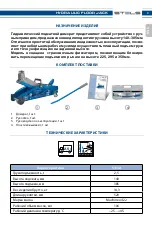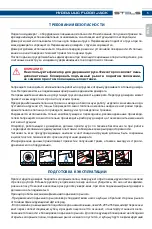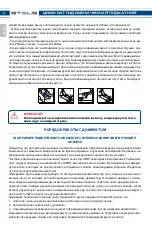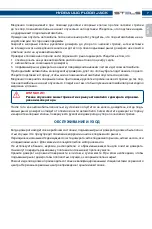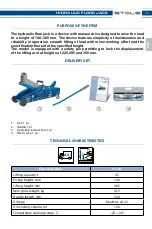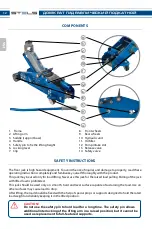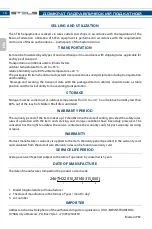
hydraulic floor jack
eng
13
It is prohibited to stay or carry out works under the lifted load held only by the jack. Stay away from moving
hinged joints of the jack.
Never exceed the maximum rated lifting capacity of the jack. Overload of the jack may result in its failure
and cause personal injury.
The safety valve is adjusted for safe operation of the item with maximum rated load of 2.5 tons. It is
prohibited to change factory settings of the safety valve at your own discretion; it may cause failure of the item
and personal injury.
It is permitted to use only the components and adapters recommended for use by the manufacturer.
It is prohibited to disassemble the jack on your own initiative, as well as make changes and modifications
in the construction of the jack.
The operator working with the jack should be cautious, competent, should have passed a training course
and have a qualification in safety techniques when working with servo motors and their moving parts,
and should preserve safety measures while operating the jack.
All warning labels should always be legible and these operating instructions should be kept intact during
the whole service life of the jack.
Failure to heed these rules may result in causing personal injury and failure of hydraulic equipment.
BEfORE USE
Test the jack. Close the release valve by turning it with the help of the handle clockwise until it is firmly
closed. Insert the handle into the pump unit handle sleeve and make sure that it is reliably fixed in the slot.
Pump handle several times up and down; when this is done, the lifting arm of the jack should start rising.
Principle of operation of the lifting arm safety pin
- While the lifting arm moves upwards under the action of the pump, the teeth of the back side of the
lifting arm drive the safety pin forward.
- In the positions equal in height to somewhat higher than 225, 295 and 350 mm the safety pin jumps over
the relevant tooth, and a characteristic click is heard. It means that the safety pin is ready to interlock
the lifting arm. For further interlocking, it is sufficient to open the release valve, the lifting arm will go a little down,
and the teeth will be pressed against the safety pin. The lifting arm is interlocked and the saddle is on a height
of 225 mm from the surface.
- To unlock the lifting arm, it is necessary to close the release valve, to insert the handle into the pump
unit handle sleeve and pump it up and down several times. The lifting arm starts rising, thus relieving the
safety pin.
- If we continue raising the arm lever, then similarly we may interlock the lifting arm at the height of 295 mm,
and then at the height of 350 mm.
- If operation of the safety pin is not required, then when the lifting arm is in the extreme down position, pump
six full strokes with the handle after which lower the locking lever down and latch it in the clip. Thus, the safety
pin will not be engaged by the teeth during further operation. If the lifting arm is raised higher than six handle
strokes, the interlocking lever may be activated for interlocking at any height. Prior to lowering the lifting arm
make sure that the interlocking lever is snatched in the clip. Otherwise, the lifting arm will be pressed against
the safety pin and stop lowering down. With the help of the handle, rotate the release valve counterclockwise
by no more than three full turns, and when the lifting arm goes down fully, close the release valve by turning
it with the help of the handle counterclockwise until it is fully closed. When the lifting arm is fully lowered
the locking lever is automatically unlocked.



